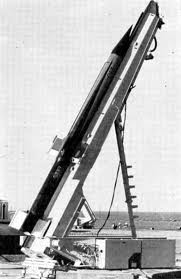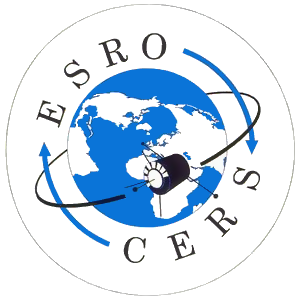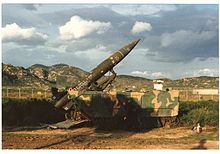
Vega is an expendable launch system in use by Arianespace jointly developed by the Italian Space Agency (ASI) and the European Space Agency (ESA). Development began in 1998 and the first launch took place from the Guiana Space Centre on 13 February 2012.

Esrange Space Center is a rocket range and research centre located about 40 kilometers east of the town of Kiruna in northern Sweden. It is a base for scientific research with high-altitude balloons, investigation of the aurora borealis, sounding rocket launches, and satellite tracking, among other things. Located 200 km north of the Arctic Circle and surrounded by a vast wilderness, its geographic location is ideal for many of these purposes.

The Italian Space Agency is a government agency established in 1988 to fund, regulate and coordinate space exploration activities in Italy. The agency cooperates with numerous national and international entities who are active in aerospace research and technology.

Skylark was a family of British sounding rockets. It was operational between 1957 and 2005.

Bélier is the designation of a French sounding rocket family. Three versions of the Bélier were launched between 1961 and 1970 at the CIEES launch facility at Hammaguir, the Salto di Quirra and Ile du Levant missile ranges, and Kourou Space Center.

Centaure was a two-stage French sounding rocket consisting of a Venus first stage and a Belier second stage. It belongs to a family of solid-propellant rockets consisting of the Belier, Centaure, Dragon, Dauphin, and Eridan.

Alfa was the designation of an Italian ballistic missile program that started in 1971 under the control of the GRS. It was related to the Polaris A-3 missile.

The European Space Research Organisation (ESRO) was an international organisation founded by 10 European nations with the intention of jointly pursuing scientific research in space. It was founded in 1964. As an organisation ESRO was based on a previously existing international scientific institution, CERN. The ESRO convention, the organisations founding document outlines it as an entity exclusively devoted to scientific pursuits. This was the case for most of its lifetime but in the final years before the formation of ESA, the European Space Agency, ESRO began a programme in the field of telecommunications. Consequently, ESA is not a mainly pure science focused entity but concentrates on telecommunications, earth observation and other application motivated activities. ESRO was merged with ELDO in 1975 to form the European Space Agency.

Avio S.p.A. is an Italian company operating in the aerospace sector with its head office in Colleferro near Rome, Italy. Founded in 1908, it is present in Italy and abroad with different commercial offices and 10 production sites. Avio operates in:

A Skylark tower was a tower used for the launch of earlier versions of Skylark rockets. As Skylark rockets had no guidance system and accelerated slowly, they required a safe launch tower with a height of at least 24 metres, with its own guidance system. Later versions of the Skylark rocket were equipped with a more powerful engine and therefore did not need such a large guidance tower for launch.
Rehbar is a series of sounding rockets launched into the upper atmosphere by Pakistan's Space and Upper Atmosphere Research Commission (SUPARCO). Rehbar-I was the first rocket launched by SUPARCO, on 7 June 1962. Rehbar-I was a two-staged solid fuel rocket.
The Poligono di Furbara was a small launchpad at the Furbara airport, in the municipality of Santa Marinella, on the Italian coast north of Rome. It was used for testing the first Italian-designed and built missiles.
C-41 was a two-stage Italian-built rocket, 75 kg (165 lb) in weight, part of a program to develop probe carrying rockets to study outer atmosphere. It was first launched on July 9, 1960, from the Salto di Quirra range. The project was managed by Lt.Col. Metallo and Engineer Angeloni.
To cut costs the C-41 recycled parts of existing weaponry. The first stage was powered by a cluster of four jets featuring interconnected combustion chambers. The payload carrying second stage was powered by a single engine of the same type. On the whole six C-41 were launched successfully.
Successive development of probe carrying rockets was the task of the newly formed Space Research Committee within the CNR. The committee's president was the founder of Italian astronautics, Luigi Broglio.

The San Marco programme was an Italian satellite launch programme conducted between the early 1960s and the late 1980s. The project resulted in the launch of the first Italian-built satellite, San Marco 1, on 15 December 1964. With the programme Italy became the third country in the world to operate a launch with its own crew, after the Soviet Union and the United States, and the fifth to operate its own satellites after also Canada, and the United Kingdom. San Marco was a collaboration between the Italian Space Research Commission (CRS), led by Luigi Broglio and Edoardo Amaldi, and NASA. In total 5 satellites were launched during the programme, all using American Scout rockets. The first flew from Wallops Flight Facility with the rest conducted from the San Marco Equatorial Range. The last satellite, San Marco-D/L, launched on 25 March 1988.

San Marco 1, also known as San Marco A, was the first Italian satellite. Built in-house by the Italian Space Research Commission on behalf of the National Research Council, it was the first of five as part of the Italian-US San Marco programme.

Luigi Broglio, was an Italian aerospace engineer, airforce lieutenant colonel and dean of the school of aeronautical engineering at the University of Rome La Sapienza. Known as "the Italian von Braun", he is best known as the architect of the San Marco programme.

Zefiro is a family of solid-fuel rocket motors developed by Avio and used on the European Space Agency Vega rocket. The name Zefiro derives from the acronym ZEro FIrst stage ROcket, conceived when this motor was intended to be used as first and second stages of San Marco program of the Italian Space Agency (ASI). After its intended use as booster was shelved the acronym was dropped and only the reference to the Greek god of the west wind Zephyrus remained.
Carlo Buongiorno was an Italian aerospace engineer, first Director of the Italian Space Agency and professor at the Sapienza University, in Rome. He was a pivotal figure in the Italian space program.

M10 is a liquid-fuel upper-stage rocket engine in development by Avio on behalf of European Space Agency for use on Vega E. The engine, initially known as LM10-MIRA, was a derivation of the existing Russian RD-0146 engine and result of a past collaboration between Avio and Chemical Automatics Design Bureau (KBKhA) ended in 2014 after the escalation of the Russo-Ukrainian conflict and consequent economic sanctions. On May 6, 2022 engine testing campaign started at Salto di Quirra, Sardinia, with consequent maiden flight on a Vega-E launcher expected by 2026 from Guiana Space Centre.















